Simple Sourdough Ciabatta Bread
This post may contain affiliate links. Please read my disclosure policy.
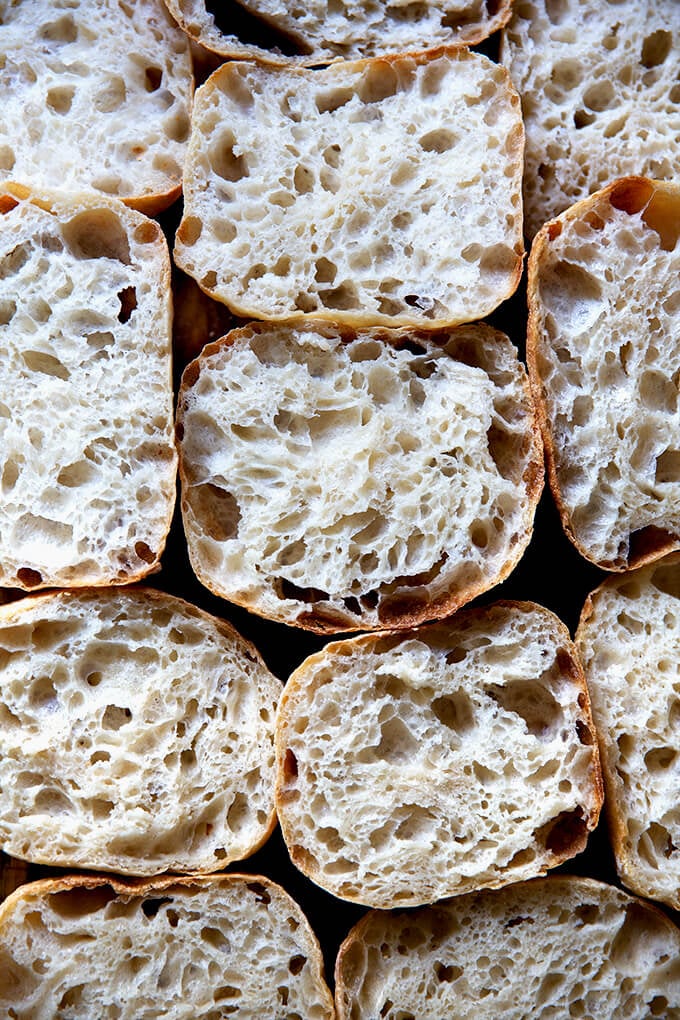
Last month, while posting a photo of this brioche loaf on Instagram, I posed a question: If 2020 was the year of banana bread and focaccia, what will be THE bread of 2021?
Which bread, I asked, did everyone want to learn how to make most?
Of all the responses, which included everything from fougasse to hoagie rolls, a crusty baguette was the most frequently cited, ciabatta following closely behind.
I’m excited to say today, after a few weeks of experiments, I have a wonderful sourdough ciabatta recipe to share. It has a thin, but crisp crust, a beautiful honeycomb crumb, and a lovely lightness and chew. It’s perfect for sandwiches.
And best of all: it’s truly simple. Made with four ingredients, this recipe requires neither an autolyse nor preferment, neither a preheated Dutch oven nor baking stone. If you have a sheet pan, you’re good to go.
What’s more, there’s no shaping or scoring, no balling up dough or creating tension. Truly, after the bulk fermentation, which includes some fridge time, you turn the dough out onto a floured work surface, pat it into a rectangle, and divide it into 8 roughly equal pieces. You then transfer those pieces, irregularly shaped and all, to a sheet pan, and bake them one hour later.
But can I tell you the most exciting part? This dough makes a decent — a more than decent — baguette! It’s not super crusty, but it’s a nice baguette nonetheless, flour-dusted and unscored, with a crumb and flavor better than any other I’ve attempted previously.
Friends, I hope you love this recipe. It’s on par with this sourdough focaccia recipe in terms of simplicity and effort, but it’s a totally different animal. I can’t wait for you to give it a try.
PS: If sourdough isn’t your thing, please try this yeast-leavened ciabatta bread recipe.
This post is organized as follows:
- 3 Tips for Sourdough Success
- What is Ciabatta?
- Sourdough Ciabatta, Step by Step
- Ciabatta Sandwich
- Sourdough Ciabatta “Baguettes” 🥖🥖🥖
3 Tips for Sourdough Success
Before you get started with this recipe, here are my three tips for sourdough bread baking.
- It starts with your starter.
- This will sound obvious, but: it starts with your starter. Before you mix a loaf of sourdough bread, you must ensure your starter is bubbly and active. I like to feed my starter at night before bed, let it rise and fall overnight; then feed it again in the morning. By midday, it’s ready.
- Use a digital scale.
- I say this all the time, but using a scale to measure the ingredients for a loaf of sourdough bread makes all the difference. So much of sourdough bread baking is simply a matter of using the precise amount of water given your environment and given the flour you are using. If you use cups to measure you are simply not being precise, and as a result, you will not be able to make meaningful adjustments should the recipe as written not work out perfectly.
- Use a straight-sided vessel for the bulk fermentation.
- With sourdough bread baking, one frequent problem bakers run into is over-fermentation. If you let the first rise go too long, the dough will over-ferment and become a sticky, unsalvageable mess. A straight-sided vessel allows you to see when your dough has truly increased in volume by 50%, 75%, 100% or whatever volume increase you are after.
- The vessel I use in this recipe, similar to this one, is 8 cups. Most grocery stores carry storage vessels similarly sized.
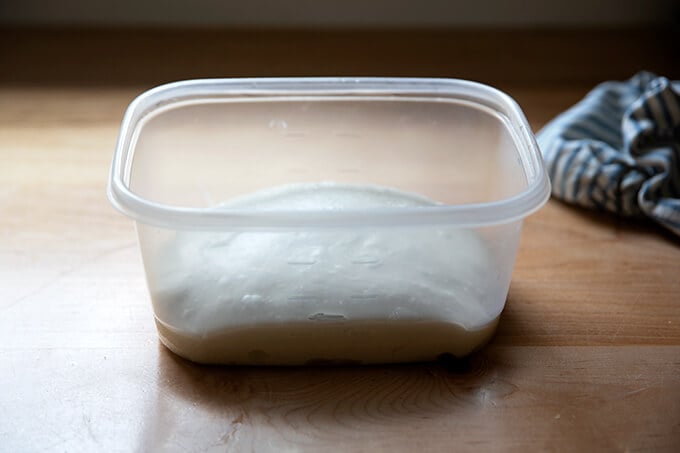
What is Ciabatta?
- Originating from the Lake Como region of northern Italy, ciabatta means “slipper” in Italian. Traditional ciabatta is characterized by this slipper shape as well as an extremely porous and chewy texture.
- Traditionally, ciabatta dough is very wet, calls for very little yeast, and requires a long, slow rise.
- Traditional recipes, too, often call for making a biga (a preferment), which helps produce that light, porous texture.
Sourdough Ciabatta, Step by Step:
Gather your ingredients: bread flour, water, salt, and a sourdough starter. I am a proponent of buying a starter (see recipe box for sources), but if you are up for it, you can build a starter from scratch in just about 1 week.
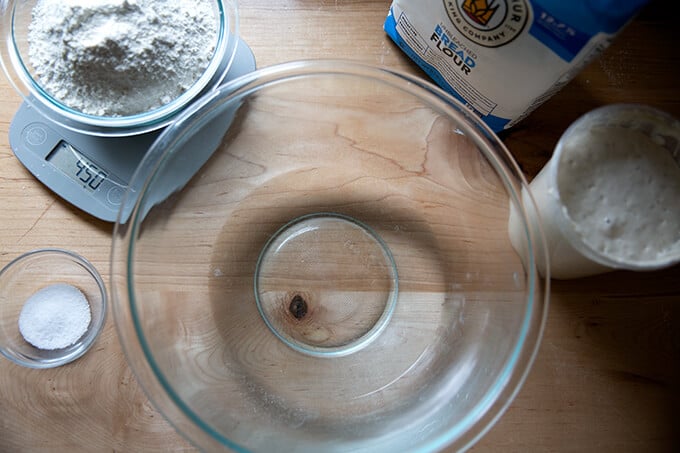
For this recipe, you’ll need: 100 grams sourdough starter, 360 grams water, 450 grams flour, and 12 grams salt. It’s 80% hydration.
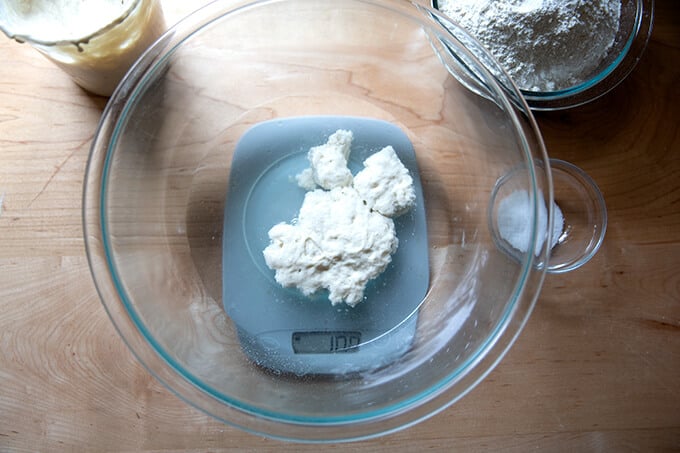
Mix together the water, sourdough starter, and salt.
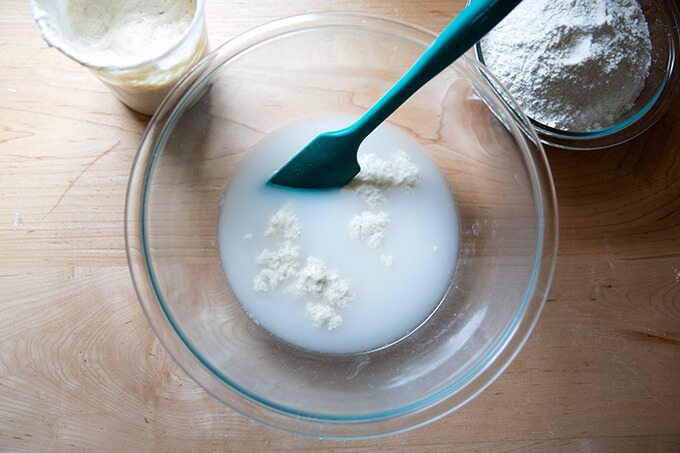
Add the flour and mix to form a sticky dough ball.
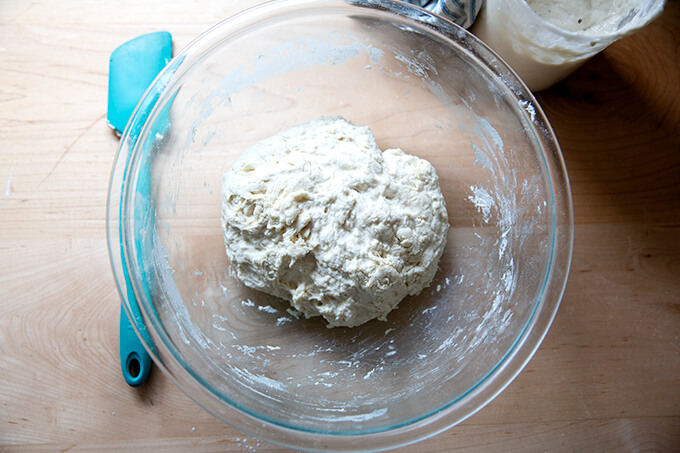
Cover the bowl and let rest for 30 minutes. Then perform a set of stretches and folds. See the video above or in the recipe box for guidance. This is what the dough will look like after one set of stretches and folds.
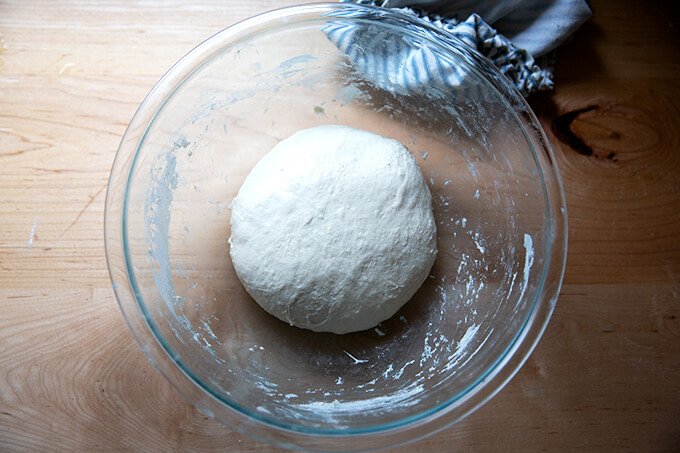
This is what the dough will look like after 4 sets of stretches and folds.
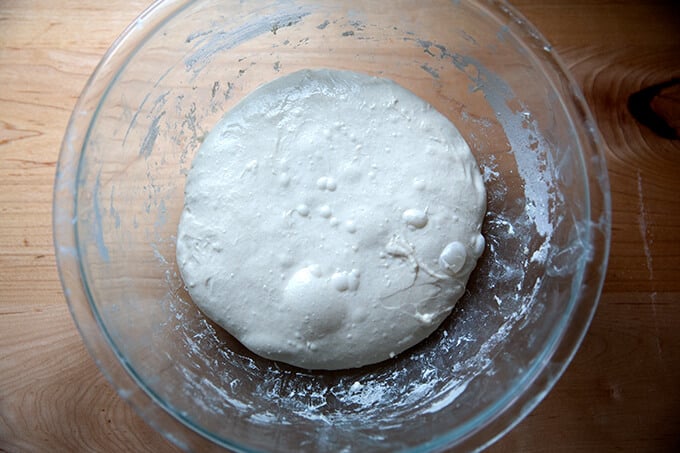
Transfer dough to a straight-sided vessel (this one is 8 cups, but anything similarly sized will do) for the bulk fermentation (the first rise):

Mark the height of the dough on the vessel, cover the vessel, and let the dough rise until it increases in volume by roughly 75%.
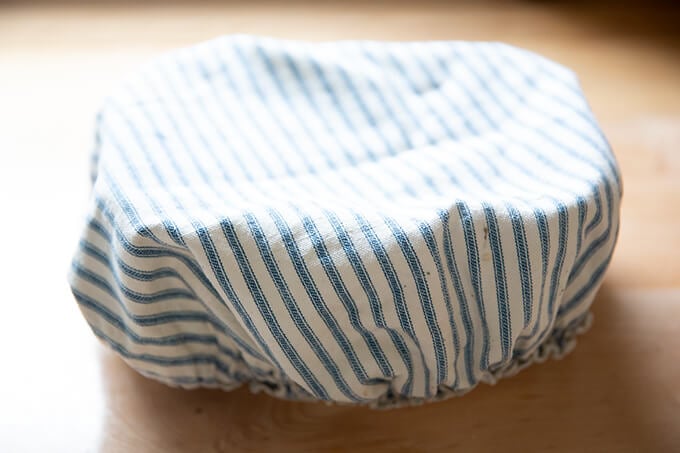
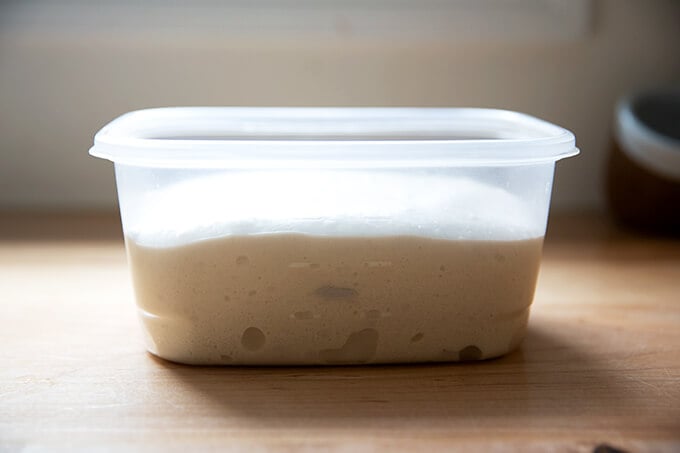
When the dough has increased by 75% (roughly), place a lid on the vessel, and transfer it to the fridge for 12-24 hours.
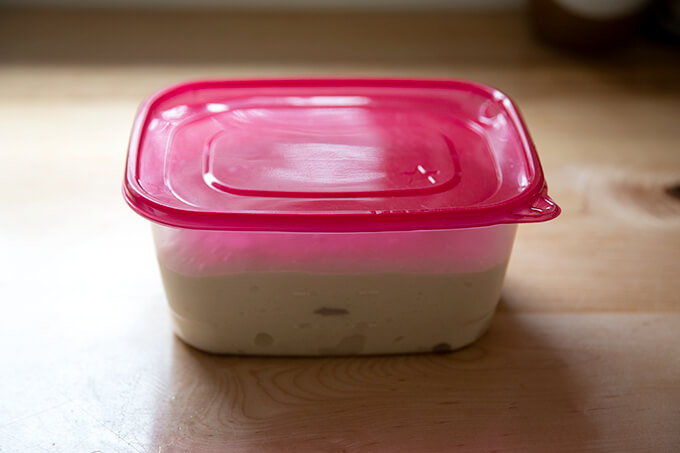
When ready to bake, remove the vessel from the fridge.
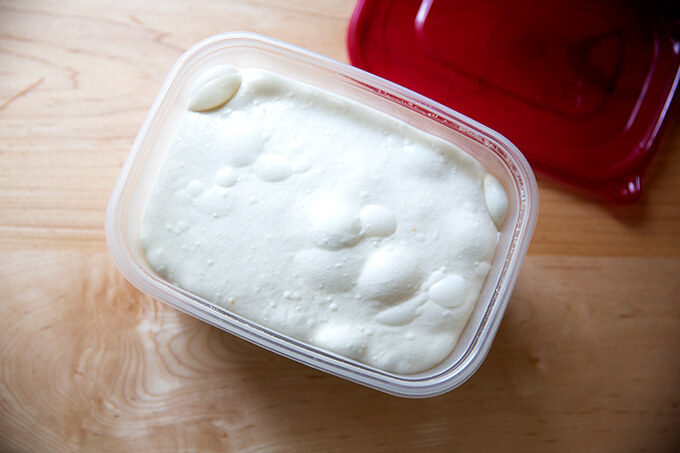
Dust the top of the dough liberally with flour. Dust a work surface liberally with flour, too.
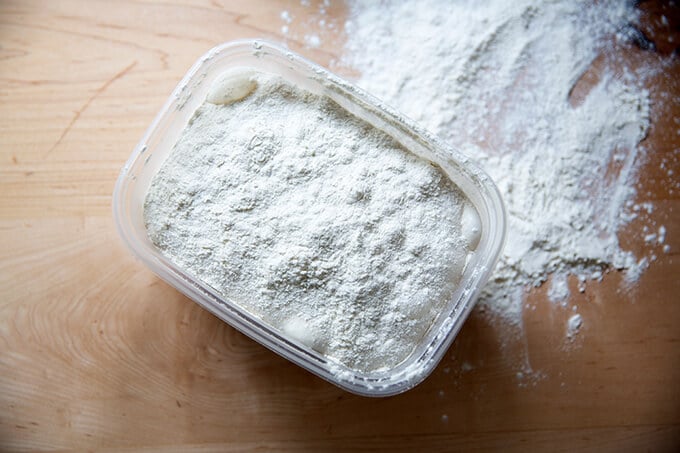
Turn the dough out onto the prepared work surface.
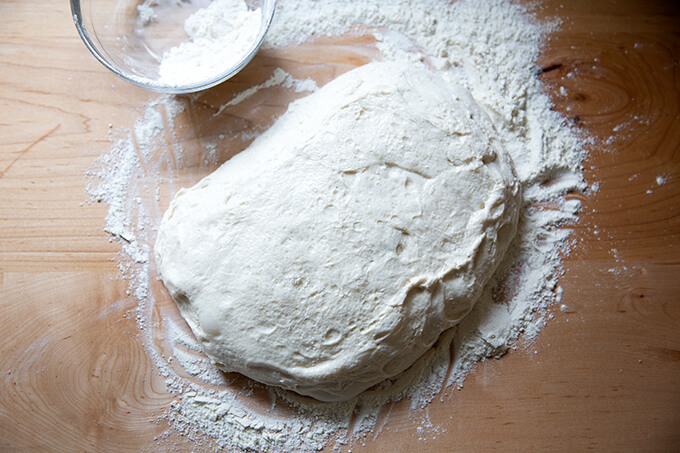
Pat the dough into a rectangle.
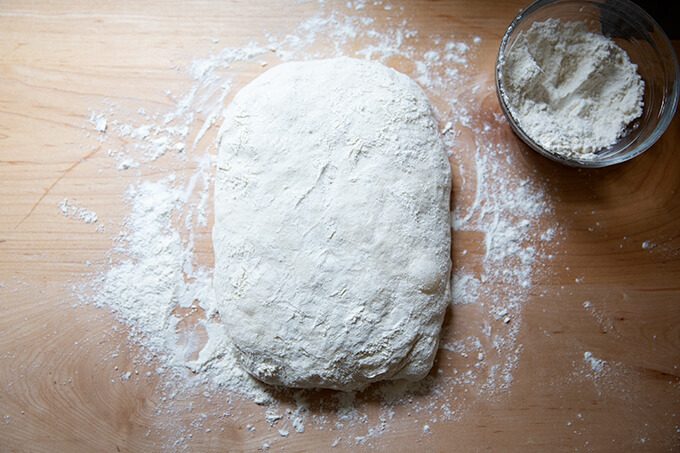
Cut the rectangle into 8 roughly equal portions.
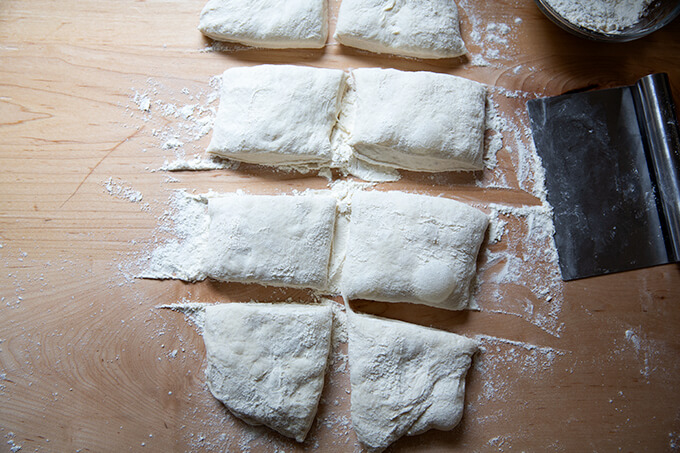
Transfer the portions to a parchment-lined sheet pan. Let rest for 1 hour. Then transfer to a 475ºF oven for 10 minutes. Lower the heat to 450ºF and bake for 10 minutes more.
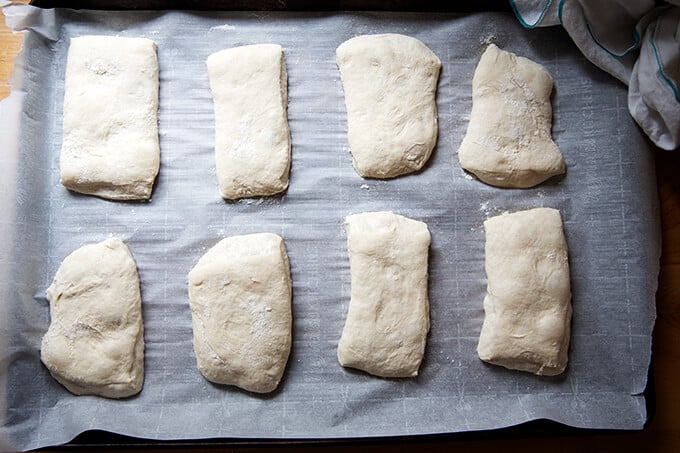
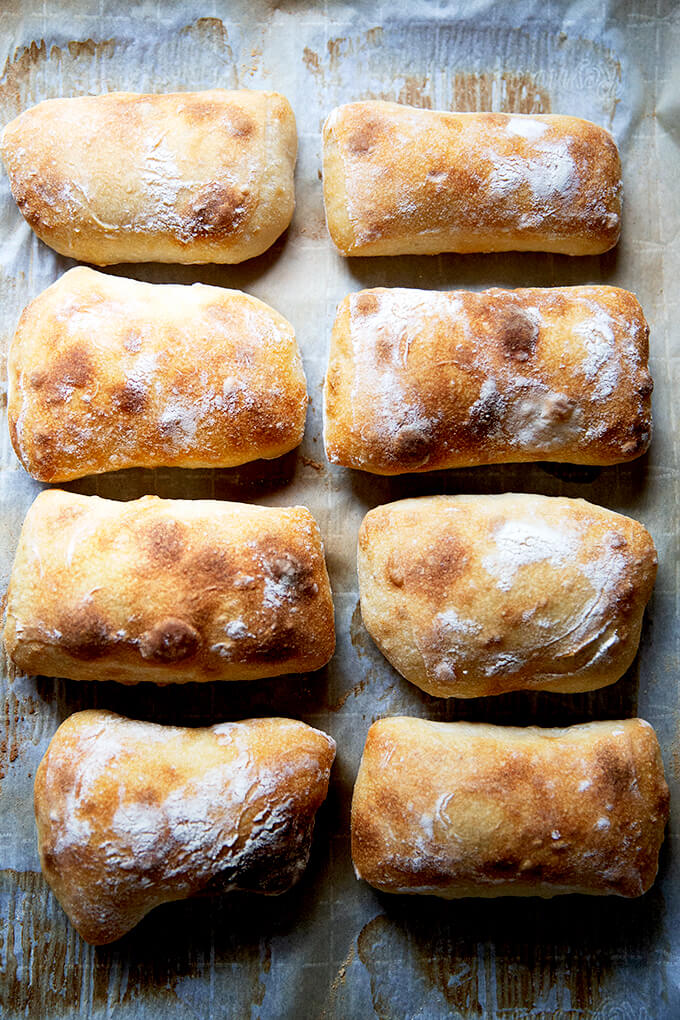
Transfer the rolls immediately to a cooling rack, and let cool for at least 20 minutes before cutting.
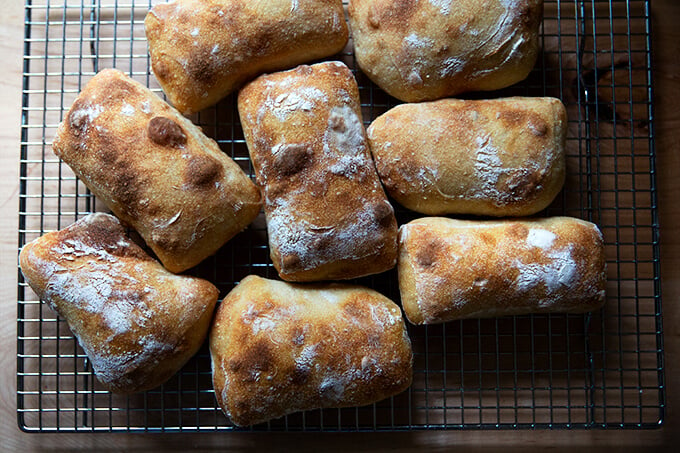
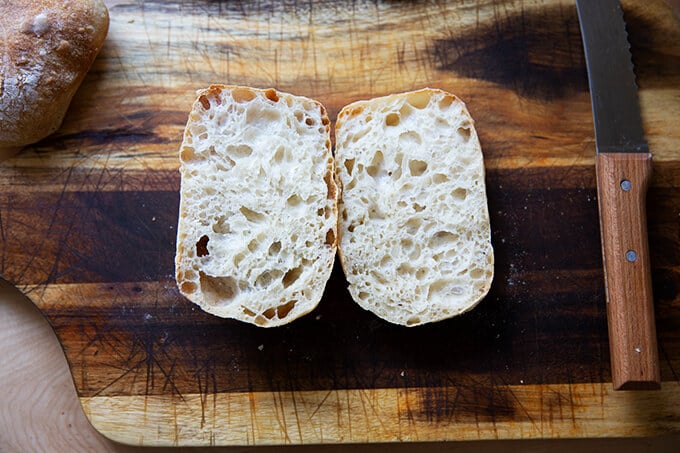
How pretty is that crumb?
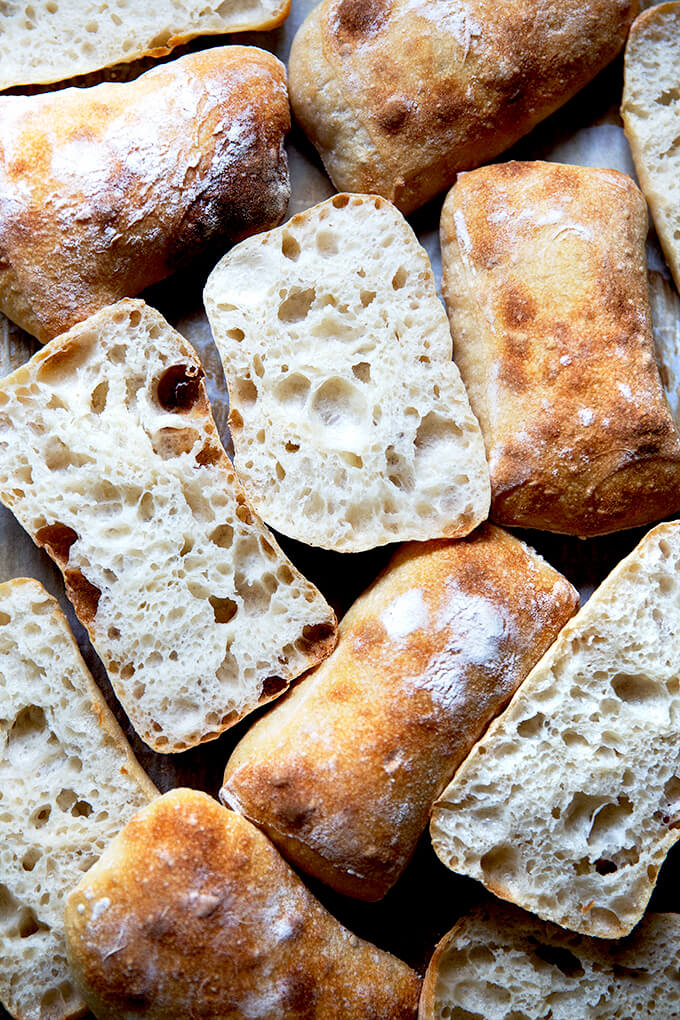
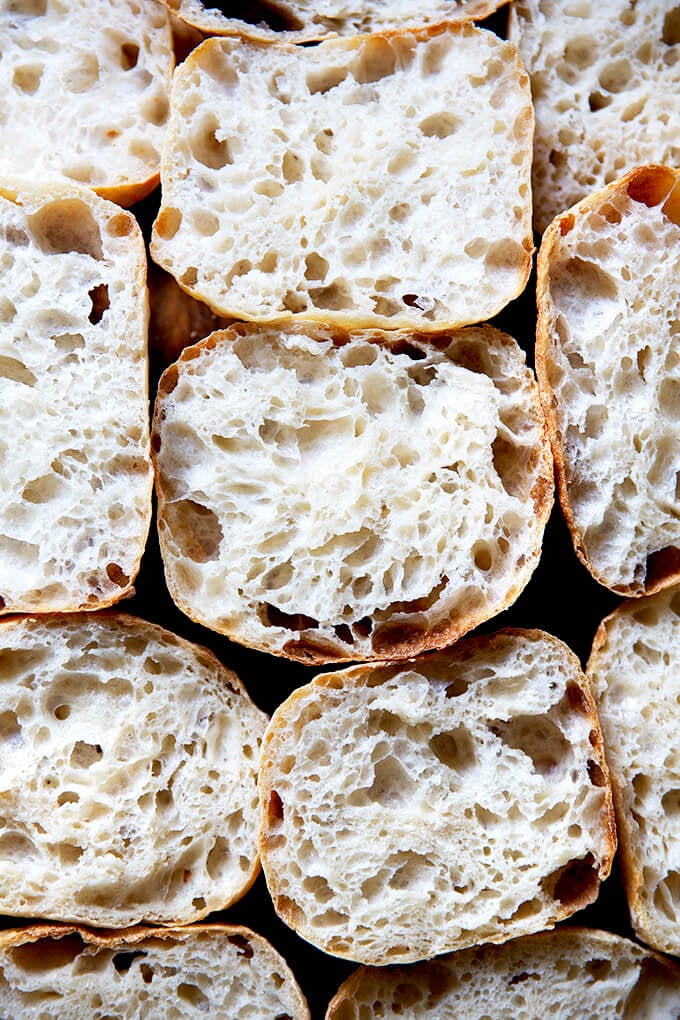
Ciabatta Sandwich
I have written about this favorite sandwich before, so forgive me if you know the story. It comes from Gabrielle Hamilton’s Blood, Bones, and Butter, a favorite book, and it’s something Gabrielle’s ex-husband, Michele, made for her during their courtship. If you have the book, the story is on page 163.
In short, the success of the sandwich relies on a delicate balance: “the perfection of three fats together — butter, olive oil, and the white fat from prosciutto or lardo.” To make it, spread good bread with “cool waxy butter,” top with prosciutto (more than you think), and arugula. Drizzle it all with good olive oil.
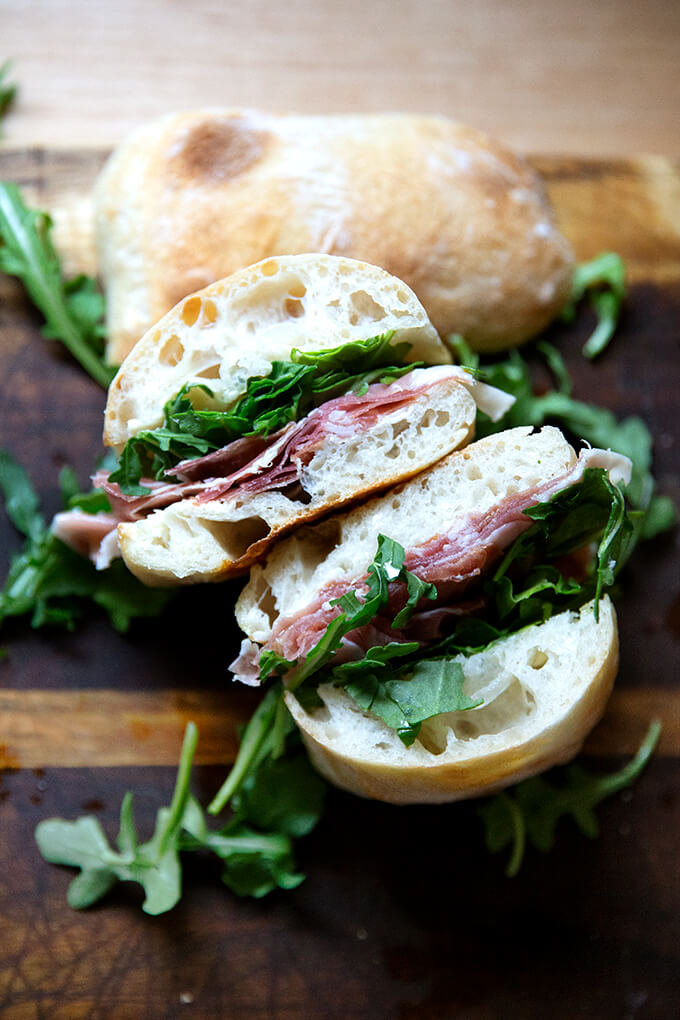
Sourdough Ciabatta “Baguettes” 🥖🥖🥖
To make baguettes, follow the same process, but instead of dividing the rectangle of dough into 8 portions, divide it into two. I find an extra-large sheet pan to be necessary to bake both baguettes at the same time. If you don’t have an extra-large sheet pan, I would bake one baguette at a time, and orient it at a diagonal angle from one corner to another.
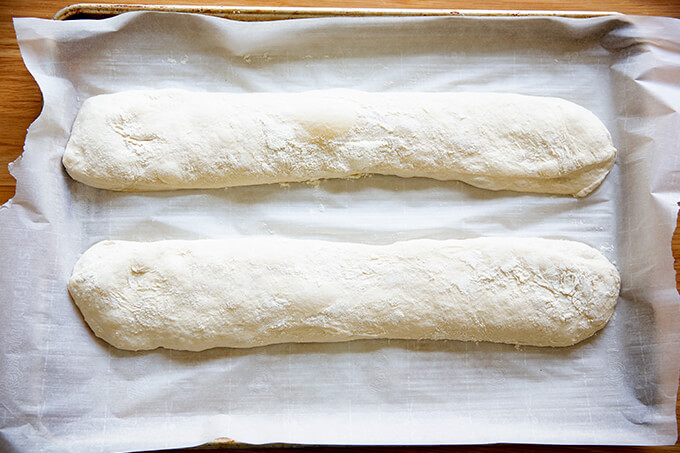
Bake the baguettes at the same temperature and for the same amount of time as the rolls.
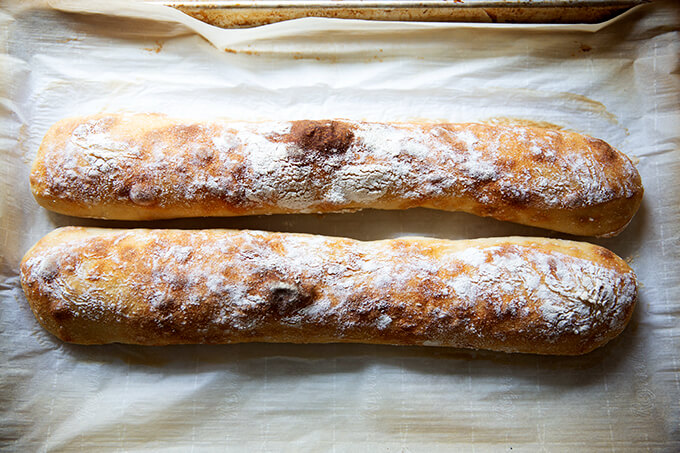
Not bad for the effort, right?
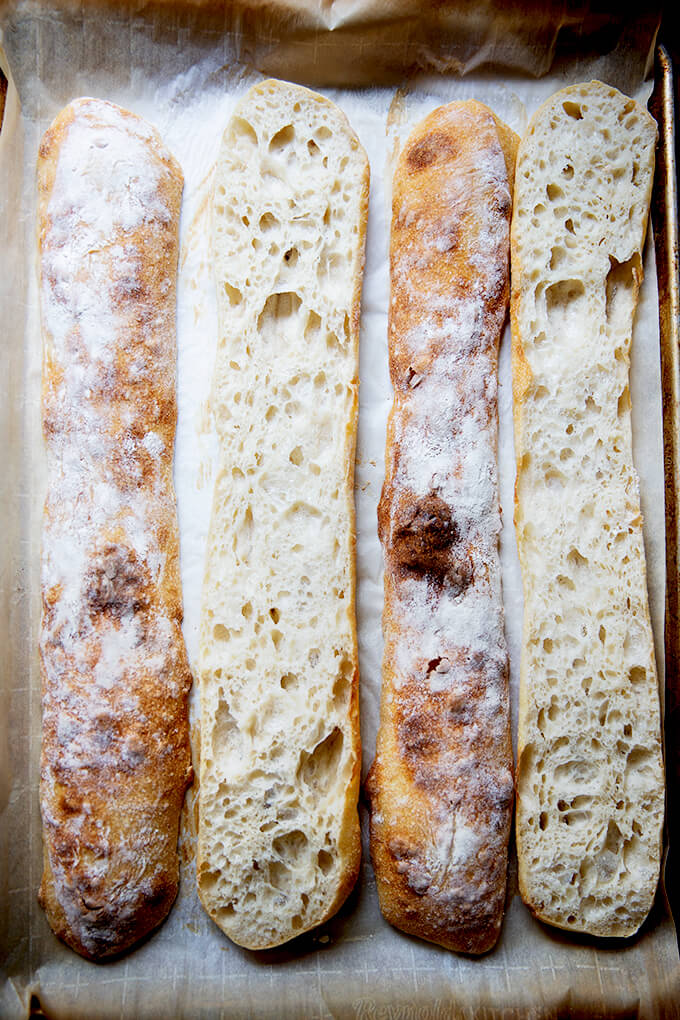
These ciabatta “baguettes” would be great vessels for giant sandwiches. I’ve been craving Bahn mi since
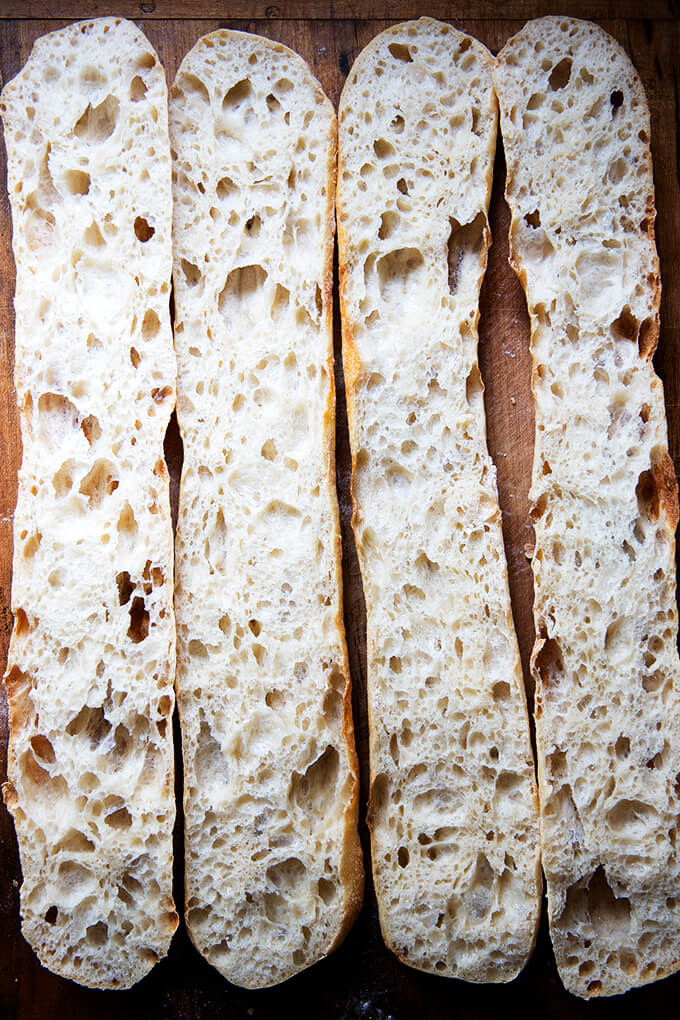
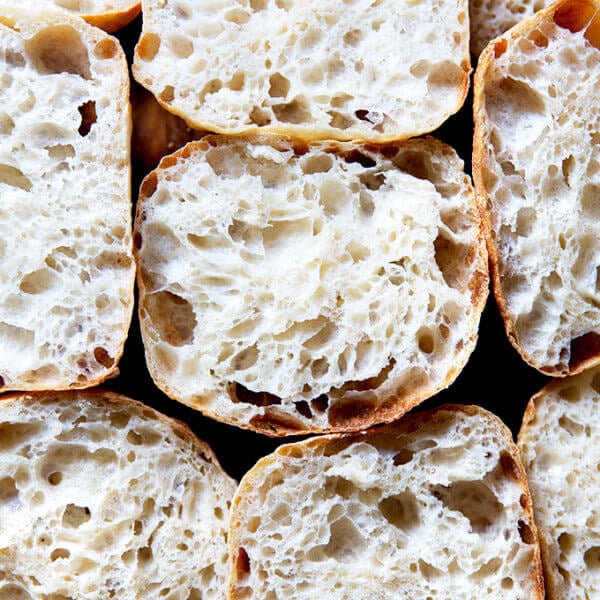
Simple Sourdough Ciabatta Bread
- Total Time: 24 hours 20 minutes
- Yield: 8 Rolls
- Diet: Vegan
Description
Notes:
- You need an active sourdough starter. You can build a starter from scratch in just about 1 week. But I am a huge proponent of buying a starter. Here are two sources:
- As always, I highly recommend investing in a digital scale before beginning any bread baking adventure.
Flour: I have had success using all-purpose flour, but if you can get your hands on bread flour, that is ideal, especially if you live in Canada or abroad. Moreover, if you live in Canada or abroad, you may need to reduce the water amount. Consider holding back some of the water during the mixing process to ensure you don’t end up with a soupy mess.
Straight-Sided Vessel:
- The vessel I use in this recipe, similar to this one, is 8 cups. Most grocery stores carry storage vessels similarly sized.
- Using a straight-sided vessel for the bulk fermentation will help prevent over-fermentation because it allows you to see when the dough has truly increased by 75% (or slightly more or less) in volume.
Ingredients
- 360 grams (about 1.5 cups) water
- 12 grams (about 2 teaspoons) salt
- 100 grams (about 1/2 cup) active sourdough starter, see notes above
- 450 grams (about 3.5 cups) bread flour, see notes above
Instructions
- Mix the dough: Place the water in a large bowl. Add the salt and stir briefly. Add the starter and stir briefly to incorporate. Add the flour, and stir until you have a wet, sticky dough ball. Knead briefly with your hands if necessary to incorporate the flour. Cover with a tea towel or cloth bowl cover and let sit for 30 minutes.
- Stretches and folds: With wet hands, grab one side of the dough, and pull up and to the center. Rotate the bowl a quarter turn, and repeat the grabbing and pulling. Do this until you’ve made a full circle. (Watch the video for more guidance. I do a few more pulls and turns in the video.) Cover the bowl. Repeat this process three more times at 30-minute intervals for a total of 4 sets of stretches and folds over the course of two hours. (In the video, I switch to coil folds for the last two sets of stretches and folds.)
- Bulk fermentation: Transfer the dough to a straight-sided vessel. Cover the vessel with a towel. Let rise at room temperature until the dough nearly doubles in volume (shoot for a 75% increase in volume). Times will vary depending on your environment and the strength of your starter. Recently, this has taken about 4 hours for me, but don’t worry if it takes longer for you. Cover vessel with a lid (ideally) or a towel (if you are using a towel, slick the top of the dough with oil to prevent it from drying out.) Transfer to fridge for 12-24 hours.
- Shape: Remove vessel from fridge. Remove lid. Sprinkle top of dough liberally with flour. Turn dough out onto a floured work surface. Pat dough into a rectangle. Sprinkle top with flour. Use a bench scraper to cut the dough in half vertically. Then make three cuts equally spaced in each half to create 8 small rectangles.
- Line a sheet pan with parchment paper. With floured hands, transfer each rectangle to the prepared pan, gently pulling outward. Cover the pan with a towel. Let stand for one hour.
- Bake: Heat oven to 475ºF. Transfer pan to oven and bake for 10 minutes. Lower heat to 450ºF, rotate pan, and bake for 10 minutes more. Remove pan from oven. Transfer ciabatta rolls to a cooling rack. Let cool for 20 to 30 minutes before slicing.
- Prep Time: 24 hours
- Cook Time: 20 minutes
- Category: Bread
- Method: Oven
- Cuisine: American, Italian
This post may contain affiliate links. Please read my disclosure policy.

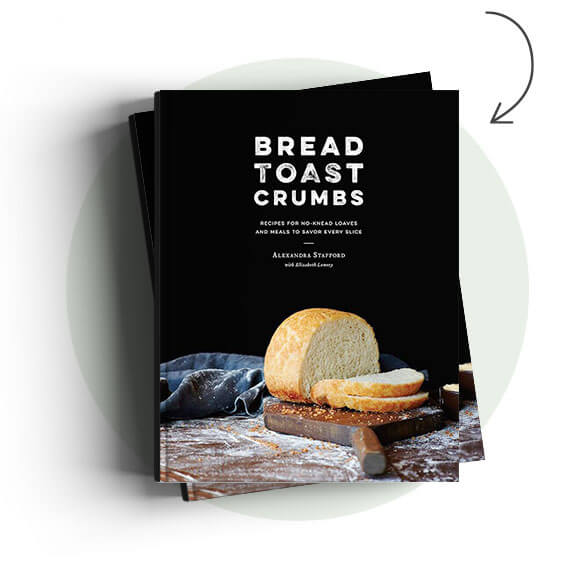




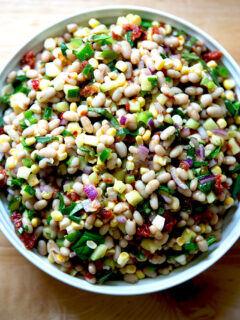
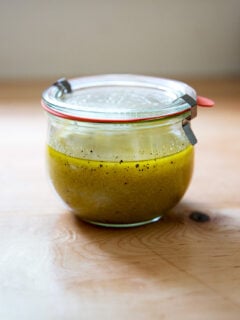



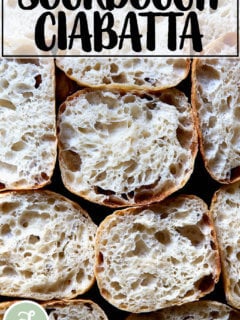
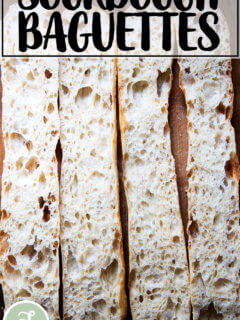
504 Comments on “Simple Sourdough Ciabatta Bread”
Hi, Basically I’m a lazy sourdough baker. Take the starter out of the fridge, put 150g in the bread machine along with the flour and a teaspoon of instant yeast, let it mix, shape and bake it. Viola! great tasting bread without a lot of bother.
But if you’re a BLT aficionado as my wife is, you need ciabatta bread with irregular holes to hold all those juices. I’ve made this recipe several times now and it has come out wonderfully every time. Using the rectangular proofing container and marking it to track the rise is genius! The rise time has varied but using this method takes a lot of the guess work out of it. Thank you so much for this recipe!
So nice to read all of this, Jerry! I also really love your lazy sourdough hybrid-yeast method — I could get into this for sure! Thanks so much for writing. It is peak BLT season and there’s nothing like having homemade ciabatta on hand to enjoy it. Happy baking!
Roughly how long (how many hours/minutes) is the first rise? I want to schedule my breadmaking as the sourdough feeding would take hours so I wonder if the first rise will take hours too before I can place it in the fridge overnight..
Hi Anne! It really all depends on the strength of your starter and the temperature of your kitchen. I would say roughly 4 to 8 hours.
Hi Ali, my first try at the sourdough Ciabatta was a fail. I’m not an experienced baker and this is only the second kind of sourdough I have tried making (I have made sourdough focaccia in the past with good results). My ciabatta turned out dense and flat. It had this air pocket on top and the rest is dense and sticky/gummy.
I did bulk ferment for 2 hours only though and put it in the fridge because my dough already doubled in just 2 hours. Should I have continued for 4 hours? I’m from South East Asia, temp is higher here.
Also, when I was mixing the ingredients, it was soupy/ a lot wetter than what yours looked like.
And during the stretch and folds, I forgot to change the method to coil for the last 2 folds. Did that contribute to the dense/gumminess?
Hi Anne,
I think there is one main issue:
1. It sounds as though you need to reduce the amount of water from the start.
Are you using a scale?
Yes I use a scale. I’ll try reducing the water next time. Is the 2 hour bulk fermentation fine if the dough rose almost 100% already?
Yes, that’s fine! Great to hear re scale. I would reduce the water by at least 75 grams.
Hi Ali,
Your Easy Whole-wheatish Sourdough bread recipe started me on my path to confidence and success with sourdough. It’s still my favorite every day bread and is the first recipe in my sourdough notebook! When I saw you had a ciabatta recipe I was delighted. The buns turned out great—I had a tomato sandwich for breakfast. 🙂
The two recipes seem similar except for the hydration—I guess I need to get scientific to understand the difference there. Making 8 more buns tomorrow… thanks so much!
Wonderful to hear this, Carol 🙂 🙂 🙂 The easy whole wheat-ish is the one I make most often as well. I have been on a sourdough hiatus in recent months, but I just started waking up my starter, and I’m ready to get back into it. I’ve got a sourdough discard cracker recipe to share soon. So glad the ciabatta buns turned out well. They’re so great for tomato sandwiches!
Delicious! What is the best way to store this bread?
Hi! Ziplock bags at room temperature or in the freezer. Always reheat on day 2 and beyond before serving.
Delicious tasting ciabatta on my first attempt. It was a little doughy on the bottom, possibly slightly undercooked but still yummy! Please can you let us know if your oven temperatures for fan ovens or conventional? That might have been my downfall…
The ONLY recommendation I have is to include internal bread temp for doneness. Completely removes the variability. I’m going to try removing at 208f internal.
Great tip, Ben! Thanks for sharing. Will add temps to recipes moving forward.
Love this recipe! Thanks it has turned out perfect every time. My family loves to use the rolls for sandwiches and for breakfast too! Poached egg on one half of the lightly toasted roll & avocado on the other half! 💕
Yum to all of this! Great to hear. Thanks for writing 🙂
I’ve been baking both your homemade sourdough and this recipe for some time now with glorious results! However, I just purchased a steam oven…basically a convection oven with a water tank to auto steam the break while cooking. Looks like you have a convection oven
My question for both of these recipes is do you use the fan on your convection oven while baking? And if familiar with steam oven…would you suggest 100% steam for highest temp (475) of bake then no steam for lower temp (450)?
Hi Carrie! I do have a convection oven but I actually never use it for baked goods — I use it for vegetables and meats. So, to answer you question, no I do not use the fan. Regarding the steam oven question… I wish I knew! I am so jealous! I bet the steam feature will make for a fabulous crust. I would google or search on youtube for videos on how to use a steam oven with sourdough. Wish I could offer more guidance!
My dough didn’t really raise, so I was worried my starter wasn’t active enough, but the ciabatta rolls puffed up nicely in the oven. They were beautiful! Crispy on the outside, soft on the inside. Nice and holey interior. Thanks!
So great to hear this Jennie! Thanks so much for writing and sharing 🙂
Hey!
I love this recipe!
I wanted to make this recipe in bulk..
Do you recommend using separate mixing bowls and rectangular containers for each recipe?
I think you can safely scale this recipe up as long as you have a large enough vessel for the bulk fermentation. Are you using a scale to measure?
These are fantastic! The recipe is straight forward, easy to follow and not as fussy as so many sourdough recipes are. They came out absolutely perfect. I am about to start another batch to bake tomorrow.
Wonderful to hear this, Jenn! Thanks so much for writing 🙂 🙂 🙂
Just made this. It was on the whole, pretty darn successful. This is only my third attempt at bread and I’m very pleased with myself. My only problem was that the top crust wasn’t very crusty but the bottom crust was great and a lovely open crumb. I used the fan at your temperatures and almost burnt at the corners 🫣. I’m wondering it you have any tips. Thanks so much for your wonderful webpage. Xxx
Hi Leigh! Maybe try not using the fan setting? I never use convection bake with my breads. My only other thoughts are to try different sheet pans or different racks in your oven (top vs bottom vs middle). Finally, you could try lowering the temperature and baking longer.
Thank you so much. Second batch just getting ready to go in now. I’m going to try a water pan in the bottom to see if that gives me a bit of a better crust. Thanks so much for your help. It really was an excellent first try. I’ll perfect this some day.
I made these today to have for sandwiches with leftover roast beef after Christmas! Had to do a quality control sample at lunch today!! I wish I had planned to make loaves of ciabatta too to have with the lasagna for Christmas Eve. Oh well, my sourdough boule will be good too! Thanks for a great easy recipe!! I will make these often!!
Great to hear, Andrea! Thanks so much for writing. No one will be sad about a sourdough boule. Merry Christmas!
I’ve made this twice in the last week or so. Once as tolls and the second time as 2 loaves. Came out great both times!! Great recipe!!
Great to hear, Andrea! Thanks so much for writing!
I’ve made this twice so far and both times came out perfect!.
My new favorite sourdough use. I did steam them for the first 8 mins then baked for another 12 after. thank you for the great youtube video and recipe, that also helped to visualize the process.
BTW, I did adjust the temp for my second batch. preheated to 475, then after I put the rolls in, steamed and reduced heat to 450 for remainder. (my oven runs hot)
Great to read all of this, Lisa! Thanks so much for writing and sharing your notes re steam, timing, and temperature — so helpful for others.
Any suggestions on adjusting oven temp? Mine came out nice and light golden on top but burnt on bottom. Rack was in middle. i know some ovens run hotter. Should i try 450 and then go down to 425? thanks so much
oops i see now all the comments about temperature adjustment – ill try some of those 🙂
Glad you found your answer! Good luck on the next go around 🙂
I make a lot of bread and I’ve tried so many recipes but this was absolutely the best one. My bread came out exactly like the photos and it’s some of the best ciabatta I’ve ever had.
Wonderful to hear, Patti! Thanks for writing 🙂
I just used this recipe today, it turned out perfect, I’ve used others but yours by far turned out much better, I did accidentally use AP flour instead of BF, next time I’ll remember.
I love sourdough baking.
Thank you 😊
Great to hear, Carol! Thanks so much for writing 🙂
This recipe looks amazing! Your blog is beautiful! And I really want to make that prosciutto sandwich. Delicious!
Great recipe. I made this last week and brought them to work for my coworkers to eat. They all loved the taste and crumb. I made only one change to your recipe for my personal preference. I spritzed the top of the rolls with water right before I put them into the oven to create a little steam and a softer top. Overall came out great!
Great to hear, David! Thanks so much for writing and sharing your water-spritzing notes — so helpful for others. Will try that, too! Thanks 🙂
Is the overnight fridge rise mandatory? Can I just go straight to the portioning (make loaves) once it has reached 75% and rise again for the hour prior to baking?
Worth a shot! I have not tried this. The fridge rise likely will make for an airier/lighter crumb, but I would love to hear how it turns out without the fridge rise.
I was wondering the same thing? Did it turn out for you with out putting it in the fridge?
I made these twice, and both times they turned out hollow inside. No crumb at all. Any idea what it could be?
It’s likely due to the bread being under-proofed. How long are you letting the shaped loaves sit at room temperature before baking them?
I don’t know how, but I made a very delicious cibatta :).
First my flour needed more water, it was still a bit dry after I added like 50 ml more water (protein 13, 5, can it be the reason ?).
Still I carried on all the steps, it did not start rising.
Hopelessly I left it in the kitchen and it was more than double like after 8 hrs. Then I put it in the fridge, and found it overflowing in the morning :))))
Shaped and baked as in translation recipe, they came out very very delicious, thin crust,chewy inside. Could be more airy like yours, but I am still very very happy. Thank you ❤️
Oh my goodness, what an adventure! Thanks so much for writing and sharing all of this — helpful for others to see how forgiving it is. Your higher protein flour definitely could be a reason for your dough needing more water — higher protein flours tend to be thirstier.
Hi Ali,
Loved the recipe! One thing that I noticed when doing the stretch and folds is that my dough was much more dense than what was shown in your video. I added a bit more water (not much though). After the final leavening in the fridge it was still dense, with only a few small air bubbles. I don’t have a scale, but my measurements were precise. Any advice?
Hi Amanda! Are you new to sourdough or have you baked other loaves successfully? Did the first rise go OK? What type of flour are you using? Unfortunately, without a scale, you can not truly measure precisely, so my first bit of advice would be to invest in a digital scale, especially if you like baking and want to do more of it. It’s such an important tool.
Perfection! I had to throw my dough into the fridge earlier than at 75% rise, but brought it out after 18 hours, let it reach that point and the rolls came out exactly as hoped for. Excellent recipe.
Great to hear! Thanks so much for writing and sharing your notes.
Hi,
Do you ever bake your sourdough bread (any style) in a convection oven? I have both a convection and regular. Baked your ciabatta in my convection, I think it’s ok( it’s cooling right now). Just curious if you stick to a standard oven.
I have a convection setting but I actually never use it for bread because I’ve always worried the convection might cause it to brown too quickly before the inside cooks, but I’m probably being overly cautious. Were you happy with the ciabatta results?
This recipe is fantastic! Curious how long I could leave the dough in the fridge before baking… would a couple days be ok, or even longer? Thanks for your wonderful recipes!
Great to hear 🙂 I’d try for 48 hours at the most.
Hey! Love all your recipes. Just a question, most of other sourdough ciabatta recipe calls for steam oven, or to create steam in the oven prior to baking, but your recipe doesn’t mention it. Does it not make the ciabatta too crusty?
You can try any of those methods if you’d like! I don’t find it to be necessary with this one, but I don’t think it will hurt it either if you’d like to experiment. You could also try using it with half of the dough and see how it compares to the other half made without it.
I just tried the recipe. The video was wonderful to have, as it helped so much to get a visual. I use home ground flour. Any recommendations on how to get a better ride with this recipe? With home ground flour I’m noticing breads just don’t have the same rise and softness. I used a combination or Hard Red Wheat and Hard White Wheat.
Michelle, home-ground flour will make for a much denser loaf. You’ll likely need to add an autolyse step: soak the flour in the water before adding the salt and sourdough starter. This can be as short as 20 minutes or as long as 2 hours (or longer). This will help the gluten develop. That said, your ciabatta likely will still be on the dense side if you use 100% home-ground flour.